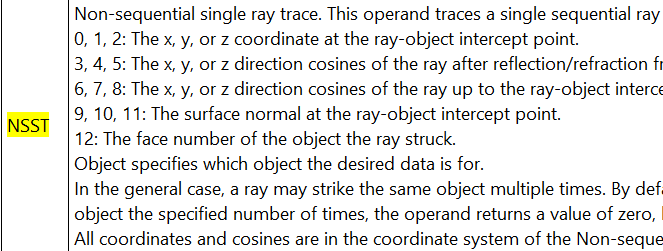Hello,
I’m missing the NSST operand in the merit function. It is listed in the documentation, but not available in the Merit function. My OS version is Ansys 2022 R2.0.

Hello,
I’m missing the NSST operand in the merit function. It is listed in the documentation, but not available in the Merit function. My OS version is Ansys 2022 R2.0.

Best answer by MichaelH
The NSST operand is designed for mixed-mode systems where you have a non-sequential component buried inside a sequential system. If you open any sequential system, you can see the NSST is available in the MFE. So both the software and the documentation are correct.
Even if NSST was available, it would still be very difficult to get the results you want. You would need to 3 operands to get the XYZ for one object, 3 operands to get the XYZ for the second object, 3 DIFF operands, 1 operand to sum the squares and 1 operand to take the square root. So you would need a total of 11 operands just to get the distance between 2 objects.
As for your specific case, if you want to optimize the distance via the MFE, the easiest option will be to do this piecemeal and to temporarily set the second object to ABSORB. Then you can use Seg = -1 rather than needing to count the individual segments. A more robust option would be to use either the ZPL or ZOS-API to script this process.
Enter your E-mail address. We'll send you an e-mail with instructions to reset your password.